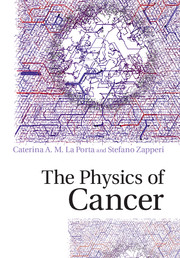Book contents
- Frontmatter
- Dedication
- Contents
- Preface
- 1 Introduction to the Cell
- 2 The Biology of Cancer
- 3 A Modeling Toolbox for Cancer Growth
- 4 Vascular Hydrodynamics and Tumor Angiogenesis
- 5 Cancer Stem Cells and the Population Dynamics of Tumors
- 6 Biomechanics of Cancer
- 7 Cancer Cell Migration
- 8 Chromosome and Chromatin Dynamics in Cancer
- 9 Control of Tumor Growth by the Immune System
- 10 Pharmacological Approaches: Old and New
- 11 Outlook on the Physics of Cancer: A New Interdisciplinary Area
- References
- Index
10 - Pharmacological Approaches: Old and New
Published online by Cambridge University Press: 04 May 2017
- Frontmatter
- Dedication
- Contents
- Preface
- 1 Introduction to the Cell
- 2 The Biology of Cancer
- 3 A Modeling Toolbox for Cancer Growth
- 4 Vascular Hydrodynamics and Tumor Angiogenesis
- 5 Cancer Stem Cells and the Population Dynamics of Tumors
- 6 Biomechanics of Cancer
- 7 Cancer Cell Migration
- 8 Chromosome and Chromatin Dynamics in Cancer
- 9 Control of Tumor Growth by the Immune System
- 10 Pharmacological Approaches: Old and New
- 11 Outlook on the Physics of Cancer: A New Interdisciplinary Area
- References
- Index
Summary
Traditional approaches to treat cancer rely on surgery, radiotherapy and chemotherapy. There is a current effort to improve the efficacy of drug delivery by using nanotechnology, encapsulating drugs inside nanoparticles. We discuss these methods in Section 10.1. Evidence of the relationship between cancer and nutrition has been accumulating over the years. We discuss this point in Section 10.2.
The Traditional Approaches and Nanomedicine
Current cancer treatments consist of surgery, radiotherapy and chemotherapy. Removal of the bulk of the tumor by surgery still remains the most effective treatment for cancer. Evidence exists, however, that surgery may induce an acceleration of tumor and metastatic growth due to the inflammatory response associated with wound healing (Coffey et al., 2003). Radio- and chemotherapy are often used to eliminate possible peripheral cells that are not completely eradicated by surgery and to control cancer growth activated by wound healing. Some tumors such as melanoma are radio-resistant, and therefore chemotherapy is the only possible alternative strategy apart from surgery.
Chemotherapy is not always effective due to problems in drug delivery, drug resistance and toxicity for the patients. Resistance to chemotherapy can have various causes in which a big role could be played by the large cell-to-cell variability inside a tumor, even within the same patient (Kessler et al., 2014). The current strategy is to use a combination chemotherapy, referring to the simultaneous administration of two or multiple therapeutic agents (Greco and Vicent, 2009; Dai and Tan, 2015; Xu et al., 2015; Pacardo et al., 2015). The main idea is that choosing an appropriate drug combination can help prevent cancer drug resistance and improve target selection and therapeutic action. An important limitation of combination chemotherapy stems from the different kinetics associated with each drug, making it difficult to obtain a simultaneous combined action. Furthermore, it is important to remark that the systemic toxicity of combination chemotherapy might be significantly enhanced due to the sum of side effects of separated drugs, which could enormously limit the effectiveness of combination therapy in the clinic.
Nanotechnology represents a promising strategy to improve drug delivery, allowing for easy drug administration, improved accumulation at the tumor site and at the same time minimization of side effects for the patient (Langer, 1998; Saltzman and Olbricht, 2002; Peer et al., 2007; LaVan et al., 2003; Farokhzad and Langer, 2009).
- Type
- Chapter
- Information
- The Physics of Cancer , pp. 132 - 137Publisher: Cambridge University PressPrint publication year: 2017

